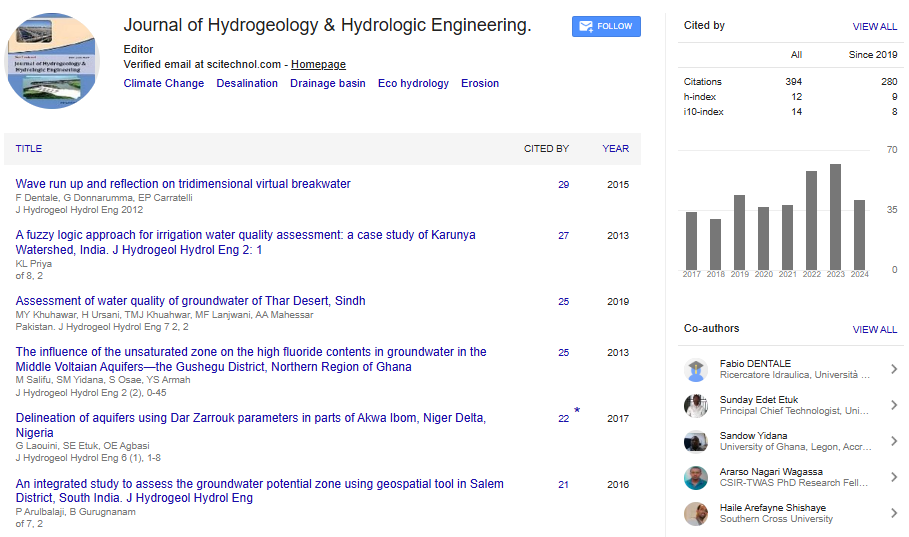Commentary, J Hydrogeol Hydrol Eng Vol: 13 Issue: 6
Drainage Basins and Groundwater Recharge: Interactions and Management Strategies
Lars Henriksen*
1Department of Hydrometeorology, Saint Petersburg State University, Saint Petersburg, Russia
*Corresponding Author: Lars Henriksen,
Department of Hydrometeorology, Saint
Petersburg State University, Saint Petersburg, Russia
E-mail: henriksenl47@gmail.com
Received date: 26 November, 2024, Manuscript No. JHHE-24-154126;
Editor assigned date: 28 November, 2024, PreQC No. JHHE-24-154126 (PQ);
Reviewed date: 12 December, 2024, QC No. JHHE-24-154126;
Revised date: 20 December, 2024, Manuscript No. JHHE-24-154126 (R);
Published date: 27 December, 2024, DOI: 10.4172/2325-9647.1000356.
Citation: Henriksen L (2024) Drainage Basins and Groundwater Recharge: Interactions and Management Strategies. J Hydrogeol Hydrol Eng 13:6.
Description
A drainage basin, also known as a watershed or catchment area, is a fundamental geographical unit that plays a precarious role in hydrology, environmental sustainability and human development. It represents the land area where all precipitation collects and drains off into a common outlet, such as a river, lake, or ocean. This article delves into the structure, processes and significance of drainage basins in both natural and human contexts.
The structure of a drainage basin
A drainage basin is defined by its boundaries, known as drainage divides or watershed boundaries. These divides are typically high points in the landscape, such as ridges or mountains, which separate one basin from another. The primary components of a drainage basin include:
Source areas: The origins of streams or rivers, often located in mountainous or highland regions.
Tributaries: Smaller streams or rivers that feed into a larger watercourse, increasing its flow.
Main river channel: The primary watercourse that channels collected water to the outlet.
Outlet: The point where the river discharges into a larger body of water, such as an ocean or a lake.
Drainage basins vary in size and complexity, ranging from small catchment areas feeding into local streams to vast systems like the Amazon Basin, which covers millions of square kilometers.
The function of drainage basins
Drainage basins serve as natural systems for collecting, storing and transporting water. They regulate the hydrological cycle and are influenced by factors such as precipitation, evaporation, infiltration and runoff. The processes within a drainage basin include:
Precipitation capture: Rain or snow that falls within the basin contributes to its water resources.
Surface runoff: Water flows over the land, transporting sediment, nutrients and pollutants.
Infiltration and percolation: Water seeps into the ground, replenishing aquifers and supporting ecosystems.
Discharge: Rivers and streams channel water to the basin’s outlet, maintaining downstream ecosystems and communities.
The importance of drainage basins
Drainage basins are vital for ecological balance, human livelihoods and regional development. Their significance can be categorized into environmental, economic and social aspects.
Environmental importance: Drainage basins are home to diverse ecosystems, including forests, wetlands and aquatic habitats. They support biodiversity by providing essential resources such as water, nutrients and shelter. Basins also play a essential role in regulating climate by influencing regional weather patterns and acting as carbon sinks through vegetation.
Economic importance: Drainage basins support agriculture, industry and energy production. They supply water for irrigation, drinking and hydropower generation. Major cities and industries often develop around rivers and lakes, relying on drainage basins for transportation and resource extraction.
Social and cultural significance: Historically, human settlements have flourished around drainage basins due to their abundant resources. Rivers and streams often hold cultural and spiritual significance for local communities. Additionally, they provide recreational opportunities such as fishing, boating and tourism.
Despite their importance, drainage basins face numerous challenges. Urbanization, deforestation and agricultural expansion have disrupted natural hydrological processes. Pollution from industrial and agricultural runoff degrades water quality, affecting both ecosystems and human health. Climate change improves these issues by altering precipitation patterns and increasing the frequency of extreme weather events, such as floods and droughts.
Sustainable management of drainage basins is essential to address these challenges. Integrated Water Resources Management (IWRM) is a full approach that considers the interconnectedness of water, land and ecosystems. Measures such as reforestation, wetland restoration and pollution control can help maintain the health of drainage basins. Community involvement and international cooperation are also vital for transboundary basins.
Conclusion
Drainage basins are dynamic systems that support life, drive economies and shape landscapes. Their sustainable management is precarious for ensuring water security, preserving biodiversity and fostering flexibility to environmental challenges. By recognizing their importance and addressing threats, we can protect these vital resources for future generations.
 Spanish
Spanish  Chinese
Chinese  Russian
Russian  German
German  French
French  Japanese
Japanese  Portuguese
Portuguese  Hindi
Hindi 
